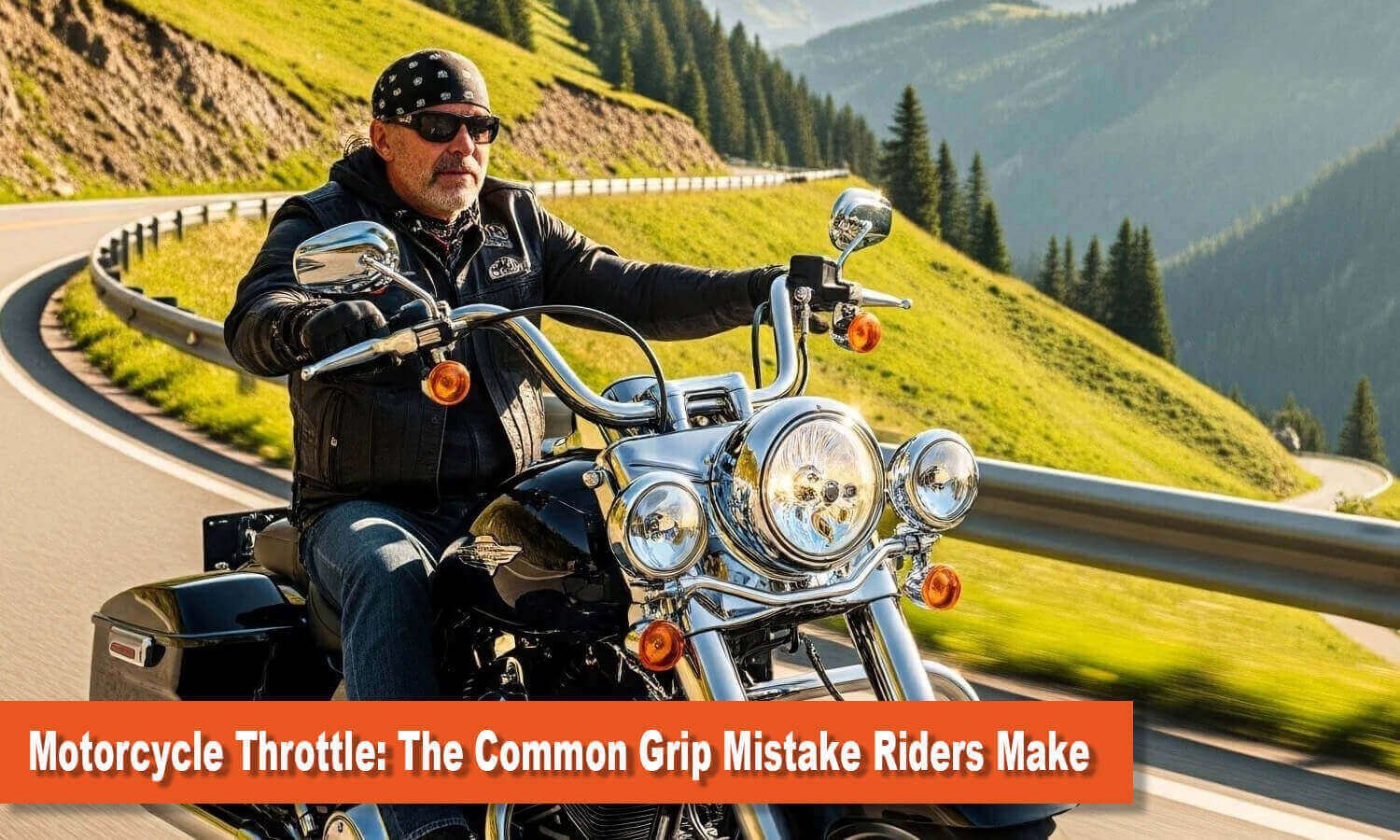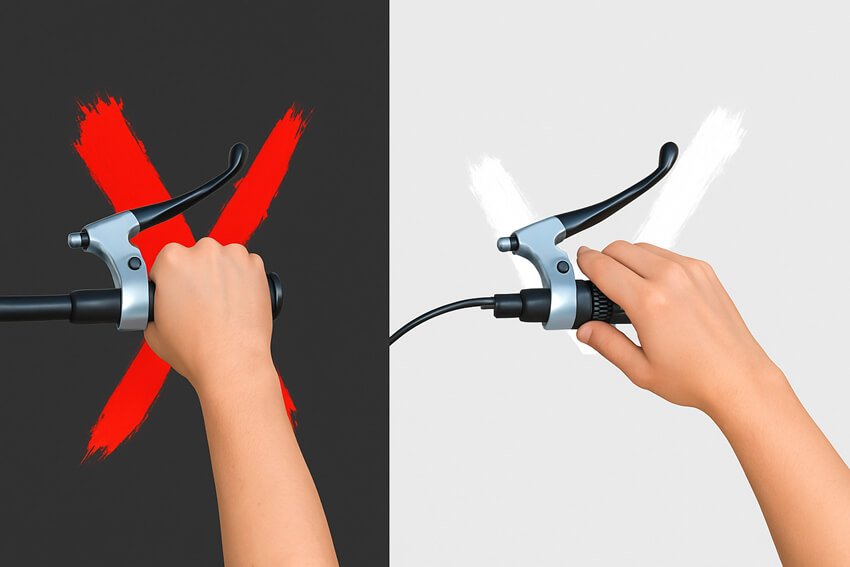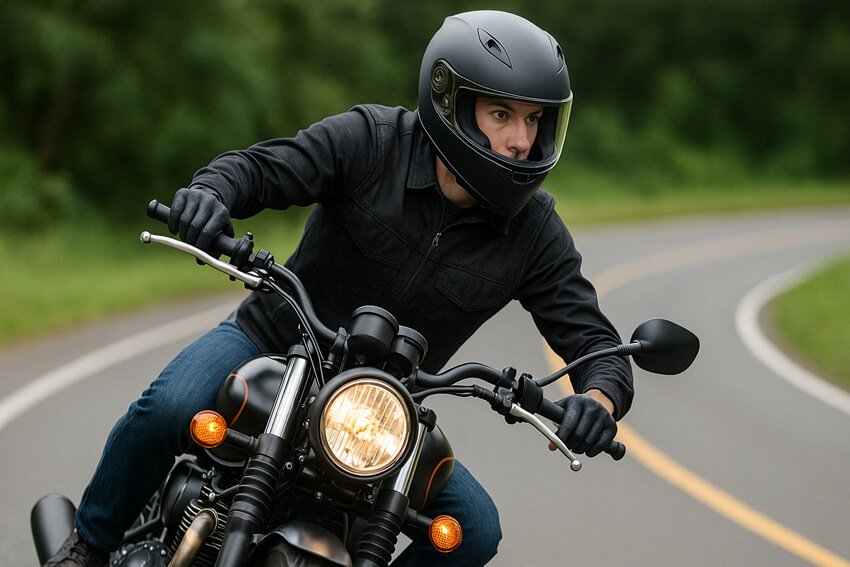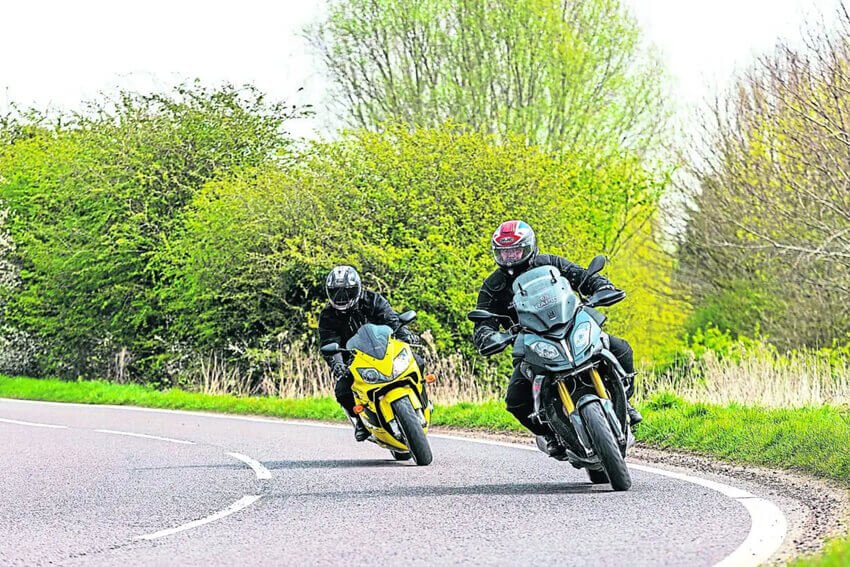Getting your snowmobile’s track adjusted correctly doesn’t have to be complicated. In this guide, we’ll show you the tools, step-by-step instructions, and troubleshooting tips for all major brands — Polaris, Ski‑Doo/Lynx, Arctic Cat, Yamaha, and more. If you do it right, your snowmobile will run great quickly. Why Track Tension Matters Track tension directly affects […]

Motorcycle Throttle: The Common Grip Mistake Riders Make
Many riders instinctively “death grip” the motorcycle throttle and handlebars, thinking it gives better control. In reality, this tension hurts your riding. As one expert notes, “your riding suffers when you grip the handlebars too tightly”. Fear and anxiety can make this worse – our bodies naturally clamp down on the grips when we’re nervous. The result is neck and shoulder fatigue, muddled steering inputs, and even lost traction in a corner.
Riders’ schools now recommend a different approach: hold the throttle lightly and with a lower wrist angle – as if you were holding an ice cream cone. This simple change can improve both safety and performance.
Table of Contents
Why a Tight Grip Hurts Your Control
When tension kicks in, riders “tighten our hands on the grips while our body tenses up”. This elbow-flailing, fist-clenching grip breaks the smooth coordination between rider and machine. Rigid arms and wrists can’t accurately steer or feel subtle feedback from the bike.
In a turn, for example, a clenched grip often forces you to drag the throttle instead of smoothly twisting it – because your wrist is already at its limit. Worse, squeezing the bar hard actually muffles the precious sensations through the bars (vibrations, bumps, slipping) that tell you what the bike is doing. In short, a death-grip wastes energy and dulls your senses.
“Your riding suffers when you grip the handlebars too tightly,” warns an instructor. Riders often only realize this after their wrists ache or they struggle to corner smoothly. A relaxed grip is not only more comfortable – it is safer. By unclenching, you reduce fatigue and ensure you’re not fighting your own inputs.
Caveman Grip vs. Ice-Cream-Cone Grip

grip a motorcycle throttle
The old way – sometimes called the “caveman” or “fist” grip – means wrapping all four fingers (and even the thumb) completely around the motorcycle throttle tube. From above, the wrist is bent and your arm is tense like a barbell lift.
Many riders hold on tight out of habit or fear of sliding off. But this grip limits your wrist’s rotation when you lean the bike. If you lean far over, a fully clenched wrist simply can’t twist farther. You end up pulling the throttle instead of smoothly twisting it, which upsets the bike.
By contrast, the “ice cream cone” grip is much lighter and lower. Imagine holding an ice cream cone in front of you – you still keep a firm but gentle hold, but your wrist is dropped and you use mostly your fingers and forearm to twist.
Coach Dylan Code of California Superbike School even jokes that you should “think about ice cream” next time you ride. With this grip, your palms lightly touch the handlebar and your elbows point out. Only a couple fingers (instead of your whole fist) are wrapped around the throttle, giving your hand more room to roll open or closed even at maximum lean.
The benefit is immediate: you can still twist or close the throttle through the full range of motion as the bike leans, without hitting a hard stop on your wrist. You’re not cramming the throttle against your palm – instead the bar rests against the base of your thumb/hand and your forearm does most of the work. This makes it easier to “push and pull the bars toward and/or away from you without unintentionally also pushing down at the same time”.
In practice, that means your steering inputs are more precise (you push and pull in the steering plane), rather than accidentally pushing down and unsettling the chassis.
Overall, the ice-cream grip aligns your hands with your arms and shoulders. Your wrists stay fairly straight or only gently bent, so arm and torso muscles assist with control instead of locked wrists.
Tall riders especially notice the difference: when arms point straight down (caveman style), riders push the handlebars downward inefficiently. Dropping the elbows (ice-cream style) points your arms more forward. Now your push/pull force is aligned with the steering axis, and the bike responds faster and cleaner. In other words, the bike tips into turns with maximum efficiency, rather than fighting against a downward push.
How to Hold the Motorcycle Throttle for Better Control

hold the throttle for better control
Training instructors summarize the new grip in a few key points. Practice these tips to transform your throttle grip and handling:
1. Light, finger-only grip
Avoid squeezing the motorcycle throttle in your fist. Keep a light but secure hold using mostly your fingers. Let your palms partially release so they do not clamp the bar tightly. A gentle grip lets you easily roll the throttle open or closed with minimal effort.
2. Elbows down and out
Keep your elbows lowered and pointing outward (like an ice-cream vendor scooping). This allows your arms and shoulders to help rotate the bars. Riders with elbows high (and wrists low) often push down on the grips, which doesn’t turn the bike. By dropping your elbows, you apply force in the right plane – forward/backward – so steering inputs are more direct.
3. Push/pull, not down
Think of steering by pushing the bars away or pulling them toward you, not pushing downward. With your ice-cream grip, all your effort goes into tipping the bike over, rather than pressing the bars like a shopping cart. This aligns with how the steering actually works.
4. Keep feedback
Rest the bars lightly in the base of your palms. This actually increases the road feel: chassis vibrations and small slides will travel through your hands, giving you high-fidelity feedback. You’ll notice tire slippage or bumps sooner, which improves your situational awareness and control.
5. Lean before throttle
Especially in corners, establish your lean angle first, then roll on the throttle gradually. Never crank the throttle hard while still building lean – doing both at once overloads the tire. Instead, lean in, stabilize, then apply power. As expert instructors point out, avoid adding throttle and lean at the same time mid-corner. Pause the throttle input if you need to add more lean; only resume rolling it on once the bike is at the desired angle.
By following these steps, the throttle becomes an extension of your arm, not a clenched lever in your palm. You’ll find throttle inputs smoother and more intuitive. In fact, one riding guide notes that with the correct grip, “keeping your grip light but firm… makes it easier to twist the throttle open or closed as needed”. In other words, the small muscles in your forearm do the twisting instead of straining your fingers, leading to smoother speed control.
Better Cornering with the Right Grip
The grip technique matters most when cornering at speed. Physics dictates that a tire has limited traction (often pictured as a “friction circle”), so you must be careful how you apply forces. When you lean a bike, you use up most of the available grip for cornering. If you simultaneously crank the throttle, you’re asking the tire to handle two large forces (cornering + acceleration) at once. That can push it past its limit, causing a slide or highside.

lean first, then throttle
Experts agree on the mantra: “Lean first, then throttle.” As one coach warns, at any significant lean angle “it’s best that you do not add throttle while adding lean angle”. In practical terms, this means get the bike leaned into the turn, hold a steady roll-on throttle if needed, then smoothly unwind throttle through the exit. If you opened the throttle too early (with wrist cocked up), the contact patch gets pulled in two directions at once.
One guide explains that adding throttle too soon pulls the tire’s contact patch apart, and the traction “limit arrives sooner and without warning”. By contrast, if you lean first and then add throttle, each force is applied in turn, maximizing traction.
The ice-cream grip supports this technique. Because your grip stays light, you’re less likely to inadvertently jam the throttle while still leaning. Your forearm remains capable of rolling on throttle even as your body moves.
Meanwhile, your gentle grip ensures that the bike’s chassis and tires communicate with you – you’ll sense any front-end tuck or back-end slip through your hands before it cascades into a crash. In short, the proper grip and lean sequence work together to keep the bike within its grip circle.
Practice and Performance
Switching grips can feel strange at first. Your brain and body have to relearn the sensation of a looser hold. A useful drill is to practice at home: while holding an imaginary “ice cream cone,” swivel your wrist gently back and forth and up and down. Notice how your wrist and forearm move together as a unit. On the bike, start on easy, slow cornering.
Deliberately check your wrist: is it cocked up (too much)? Then relax and roll the throttle lightly. Try just two fingers on the throttle to start, keeping the other two fingers near or on the brake lever for support. Over a few miles, your forearm will start doing the work naturally.
On track days or twisty roads, the difference becomes clear. Riders who adopt the light, ice-cream grip report faster response and less fatigue. One article quipped: “If you want your superbike to handle like a shopping cart, go ahead and keep the caveman grip. Otherwise, loosen up.”
In practice, dropping elbows and lightening your grip is like upgrading your steering system. Everything lines up: faster turning, sharper feedback, and smoother throttle transitions.
Key takeaways: Let go of the death-grip. Adopt the ice-cream hold with wrists down and elbows out. Lean your bike into a corner first, then roll on throttle. With practice, your ride will feel more natural, responsive, and safe.
The next time you’re on the road or track, remember: hold your throttle like an ice cream cone – your bike (and your body) will thank you.
Conclusion
A relaxed grip reduces arm pump and lets you ride longer with good form. It also minimizes the chance of a surprise slide – when you’re properly loose and attentive, you’ll catch loss of traction before it gets out of control.
As your confidence grows, you’ll be able to concentrate more on smooth inputs and less on gripping for dear life.

Motorcycle mechanic, writer. Interested in motorcycle gear for years. Like to stay up to date with the newest products and techniques of the motorcycle.
Motorcycle riding is all about the sense of freedom, adventure, and thrill of the open road. But come on—being connected when you ride isn't always an easy thing. Whether you're riding with a buddy, navigating traffic in the city, or long-distance riding, effective communication is crucial. That's where the Fodsports T5 and T6 come in, […]
If you're looking for a new motorcycle intercom system this year, Fodsports has something exciting in store. The company has launched two new Bluetooth helmet intercoms: T1 and T1 Pro. Both models bring upgraded features, sleek design, and high-definition audio quality for riders who want to stay connected, entertained, and safe on the road. But […]
Fodsports T1 and T1 Pro: The Newest Bluetooth Intercoms for Riders. Whether you’re cruising on highways, exploring rugged trails, or commuting daily, clear communication is key. Fodsports is thrilled to launch its latest Bluetooth intercoms: the T1 and T1 Pro. Built for riders who demand reliability, versatility, and crystal-clear sound, these devices redefine how you […]
Many riders who aren't so tall or ladies just starting to ride bikes need to pick out the best Motorcycles for Short Riders and Women. They gotta look for three key things: a seat that's not too high up, a bike that's not too heavy, and something that looks good enough to give them confidence. […]
Fodsports FX 60C vs FX30C Pro: What's new techs are the FX 60C bringing to us? Fodsports is a brand worth-mention for helmet communication and video recording. This brand has established itself as a key player with its innovative Bluetooth camera intercom systems. Recently, Fodsports has released a new camera intercom, the FX 60C. How […]
